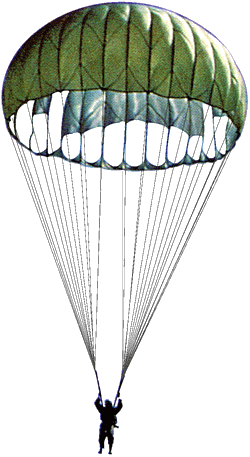
This image has format transparent PNG with resolution 250x457.
You can download this image in best resolution from this page and use it for design and web design.
Parachute PNG with transparent background you can download for free, just click on download button.
A parachute is a device used to slow the motion of an object through an atmosphere by creating drag (or in the case of ram-air parachutes, aerodynamic lift). Parachutes are usually made out of light, strong fabric, originally silk, now most commonly nylon. They are typically dome-shaped, but vary, with rectangles, inverted domes, and others found. A variety of loads are attached to parachutes, including people, food, equipment, space capsules, and bombs.
A drogue chute is used to aid horizontal deceleration of a vehicle including fixed-wing aircraft and drag racers, provide stability, as to assist certain types of light aircraft in distress, tandem free-fall; and as a pilot triggering deployment of a larger parachute.
oday's modern parachutes are classified into two categories – ascending and descending canopies.[citation needed] All ascending canopies refer to paragliders, built specifically to ascend and stay aloft as long as possible. Other parachutes, including ram-air non-elliptical, are classified as descending canopies by manufacturers.
Some modern parachutes are classified as semi-rigid wings, which are maneuverable and can make a controlled descent to collapse on impact with the ground.
Main parachutes used by skydivers today are designed to open softly. Overly rapid deployment was an early problem with ram-air designs. The primary innovation that slows the deployment of a ram-air canopy is the slider; a small rectangular piece of fabric with a grommet near each corner. Four collections of lines go through the grommets to the risers (risers are strips of webbing joining the harness and the rigging lines of a parachute). During deployment, the slider slides down from the canopy to just above the risers. The slider is slowed by air resistance as it descends and reduces the rate at which the lines can spread. This reduces the speed at which the canopy can open and inflate.
At the same time, the overall design of a parachute still has a significant influence on the deployment speed. Modern sport parachutes' deployment speeds vary considerably. Most modern parachutes open comfortably, but individual skydivers may prefer harsher deployment.
The deployment process is inherently chaotic. Rapid deployments can still occur even with well-behaved canopies. On rare occasions, deployment can even be so rapid that the jumper suffers bruising, injury, or death. Reducing the amount of fabric decreases the air resistance. This can be done by making the slider smaller, inserting a mesh panel, or cutting a hole in the slider.
In this page you can download free PNG images: Parachute PNG images free download